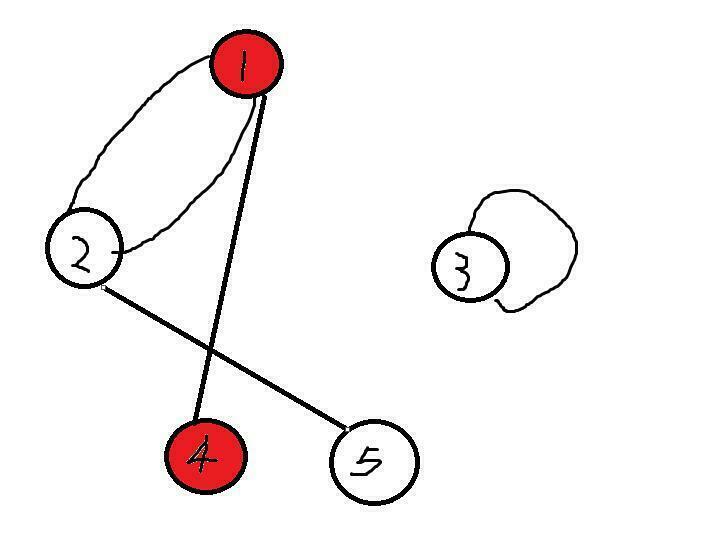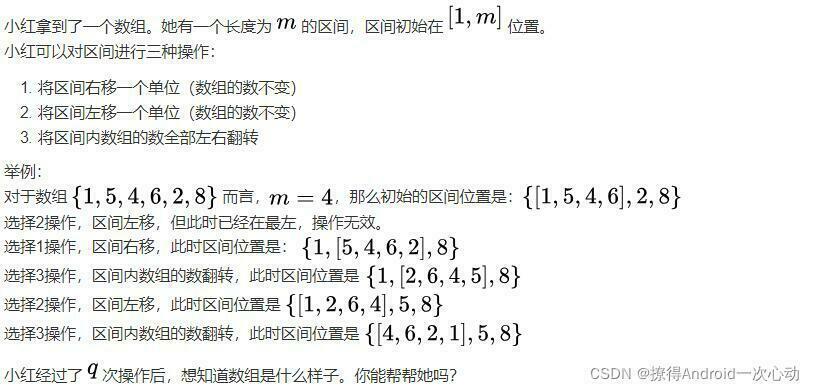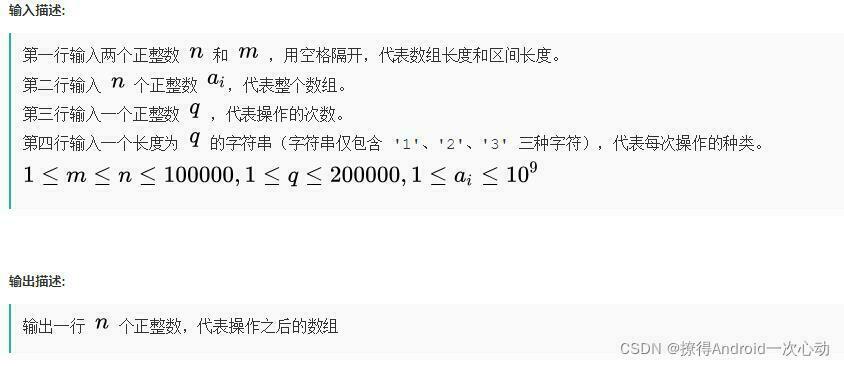

bfs(广度优先搜索),类似二叉树的层序遍历,利用队列完成。一般用于求最短路。
图的最短路问题:
给定一个无向图,每条边的长度都是1。求1号点到x号点的最短距离。 顶点数n 边数为m
q次询问 输入x 输出1到x的最短距离。 若1号点到x不连通,则输出-1
双端队列的应用(区间翻转):
对于长度为n的数组,给定一个长度为m的区间,区间初始位置为a[1]到a[m]。
3种操作:
q次操作后请你还原数组。
难度⭐⭐
知识点:bfs
首先找到k字母,然后从k字母位置开始bfs。bfs过程中即可得到k到每个e的最短路程。(要注意走过的e不可继续往下走)
题目描述:
kotori在一个n*m迷宫里,迷宫的最外层被岩浆淹没,无法涉足,迷宫内有k个出口。kotori只能上下左右四个方向移动。她想知道有多少出口是她能到达的,最近的出口离她有多远?
输入描述:
第一行为两个整数n和m,代表迷宫的行和列数 (1≤n,m≤30)
后面紧跟着n行长度为m的字符串来描述迷宫。'k'代表kotori开始的位置,'.'代表道路,'*'代表墙壁,'e'代表出口。保证输入合法。
输出描述:
若有出口可以抵达,则输出2个整数,第一个代表kotori可选择的出口的数量,第二个代表kotori到最近的出口的步数。(注意,kotori到达出口一定会离开迷宫)
若没有出口可以抵达,则输出-1。
示例1
输入
6 8
e.*.*e.*
.**.*.*e
..*k**..
***.*.e*
.**.*.**
*......e
输出
2 7
说明
可供选择坐标为[4,7]和[6,8],到kotori的距离分别是8和7步。
import java.util.*; import java.io.*; public class Main{ public static void main(String[] args) throws IOException{ BufferedReader bf = new BufferedReader(new InputStreamReader(System.in)); String[] s1 = bf.readLine().split(" "); int n = Integer.parseInt(s1[0]); int m = Integer.parseInt(s1[1]); //建立地图、标记图 char[][] maze = new char[n][m]; boolean[][] visited = new boolean[n][m]; //纪录步数 int[][] dis = new int[n][m]; //纪录初始的坐标 int ki = 0, kj = 0; for(int i = 0; i < n; i++){ String s = bf.readLine(); for(int j = 0; j < m; j++){ dis[i][j] = Integer.MAX_VALUE; char c = s.charAt(j); maze[i][j] = c; if(c == 'k'){ ki = i; kj = j; } } } int count = 0, min = Integer.MAX_VALUE; Queue<Integer> queue = new ArrayDeque<>(); //二维数组的性质,保存了坐标,并且节省了空间 queue.add(ki * m + kj); visited[ki][kj] = true; dis[ki][kj]= 0; while(!queue.isEmpty()){ int temp = queue.poll(); int tempi = temp / m, tempj = temp % m; //支持八个方向的移动或者不移动(但是因为Math.abs(i - j) == 1限定了绝对值为1,所以变成了四个方向) for(int i = -1; i <= 1; i++){ for(int j = -1; j <= 1; j++){ if(Math.abs(i - j) == 1 && tempi + i >= 0 && tempi + i < n && tempj + j >= 0 && tempj + j < m && !visited[tempi + i][tempj + j]){ if(maze[tempi + i][tempj + j] == '.'){ visited[tempi + i][tempj + j] = true; dis[tempi + i][tempj + j] = dis[tempi][tempj] + 1; queue.add((tempi + i) * m + (tempj + j)); } if(maze[tempi + i][tempj + j] == 'e'){ visited[tempi + i][tempj + j] = true; dis[tempi + i][tempj + j] = dis[tempi][tempj] + 1; min = Math.min(min, dis[tempi][tempj] + 1); count++; } } } } } if(count == 0) System.out.print(-1); else System.out.print(count + " " + min); } } 思考:队列是怎么实现bfs的?
1.起始点入队-->2.将起始点四个方向的可达点入队-->3.起始点出队。以此循序依次访问队列中的元素。
难度⭐⭐⭐
知识点:bfs,多源最短路
多源最短路的求法:在bfs开始之前将所有点都扔进队列,然后开始bfs即可。
题目描述:
小红拿到了一张无向图,有 n 个顶点和 m 条边。每条边的长度为 1 。
小红给一些顶点染成了红色。她想知道,对于每个顶点,到附近最近的红色点的距离为多少?
输入描述:
第一行输出两个正整数 n 和 m ,用空格隔开。分别代表顶点数和边数。
第二行输入一个长度为 n 的字符串,代表每个顶点的染色情况。第 i 个字符为 'R' 代表被染成红色,为 'W' 代表未被染色。
接下来的 m 行,每行两个正整数 x 和 y ,代表 x 和 y 有一条无向边相连。
不保证图是整体连通的。不保证没有重边和自环。
1<=n,m<=10^5
输出描述:
输出一行 n 个整数,代表从 1 到 n 每个顶点到最近的红色顶点的距离。若对于某点而言无论如何都走不到红色顶点,则输出 -1 。
示例1:
输入
5 5
RWWRW
1 2
3 3
1 2
2 5
1 4
输出
0 1 -1 0 2
说明

样例的图如上所示。
import java.util.*; import java.io.*; public class Main{ static ArrayList<Integer>[] g; static String[] strings; static int[] visited; static int[] dis; public static void main(String[] args) throws Exception { BufferedReader br = new BufferedReader(new InputStreamReader(System.in)); String[] firstLine = br.readLine().split(" "); int n = Integer.parseInt(firstLine[0]); int m = Integer.parseInt(firstLine[1]); g = new ArrayList[n+1]; visited = new int[n+1]; dis= new int[n+1]; for (int i=1;i<n+1;i++) { g[i] = new ArrayList<Integer>(); } //一个字符一个字符的读取 strings = br.readLine().split(""); for (int i=0;i<m;i++) { //描绘双向图 String[] temp = br.readLine().split(" "); int x = Integer.parseInt(temp[0]); int y = Integer.parseInt(temp[1]); g[x].add(y); g[y].add(x); } //g[x]代表当前点 g[x].get(i)代表所连的线 Queue<Integer> queue = new ArrayDeque<>(); for(int i=1;i<=n;i++){ if(strings[i-1].equals("R")){ queue.add(i); visited[i]=1; } } while(!queue.isEmpty()){ int temp=queue.remove(); for(int i=0;i<g[temp].size();i++){ if(visited[g[temp].get(i)]==0){ visited[g[temp].get(i)]=1; dis[g[temp].get(i)]=dis[temp]+1; queue.add(g[temp].get(i)); } } } for(int i=1;i<=n;i++){ if(visited[i]==0)System.out.print("-1 "); else System.out.print(dis[i]+" "); } } } 对照上一章的案例:小红点点点结合理解。 分别使用的dfs和bfs。
本题思想:先将红色的所有点都入队列,然后bfs。
这是一种逆向思维:不是所谓的从编号开始,并且所有走过的都不能在走了。
难度⭐⭐⭐⭐
知识点:双端队列
用一个双端队列来模拟过程,用一个变量来标记双端队列是否翻转过。


示例1:
输入
6 4
1 5 4 6 2 8
5
21323
输出
4 6 2 1 5 8
import java.io.*; import java.util.*; public class Main{ static Deque<Integer> workQueue; public static void main(String[] args)throws IOException{ BufferedReader br=new BufferedReader(new InputStreamReader(System.in)); PrintWriter pw=new PrintWriter(System.out); String[] firstLine=br.readLine().split(" "); int total=Integer.parseInt(firstLine[0]); int size=Integer.parseInt(firstLine[1]); int[] arr=new int[total]; String[] secondLine=br.readLine().split(" "); for(int i=0;i<total;i++){ arr[i]=Integer.parseInt(secondLine[i]); } int L=0; int R=size-1; workQueue=new LinkedList<>(); for(int i=0;i<size;i++){ workQueue.offerLast(arr[i]); } int times=Integer.parseInt(br.readLine()); String tries=br.readLine(); int is=0;//0代表没有翻转! for(int i=0;i<times;i++){ if(tries.charAt(i)=='1'){ if(R==arr.length-1) continue; R++; if(is==0){ workQueue.offerLast(arr[R]); int tmp=workQueue.pollFirst(); arr[L]=tmp; }else{ workQueue.offerFirst(arr[R]); int tmp=workQueue.pollLast(); arr[L]=tmp; } L++; }else if(tries.charAt(i)=='2'){ if(L==0) continue; L--; if(is==0){ workQueue.offerFirst(arr[L]); arr[R]=workQueue.pollLast(); }else{ workQueue.offerLast(arr[L]); arr[R]=workQueue.pollFirst(); } R--; }else{ is=1-is; } } for(int i=0;i<L;i++){ pw.print(arr[i]+" "); } if(is==0){ while(!workQueue.isEmpty()) { pw.print(workQueue.pollFirst() + " "); } }else{ while(!workQueue.isEmpty()) { pw.print(workQueue.pollLast() + " "); } } for(int i=R+1;i<arr.length;i++){ pw.print(arr[i]+" "); } pw.flush(); } }